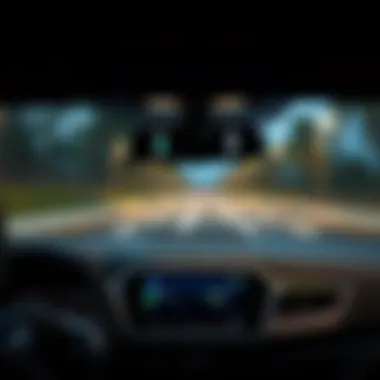Discovering the Mitsubishi Outlander PHEV: A Family-Friendly Plug-In


Intro
The Mitsubishi Outlander PHEV breaks the mold in the realm of hybrid vehicles, especially for those who are not just eco-conscious but also value spaciousness and functionality. With the growing emphasis on sustainable driving, many families find themselves at a crossroads, seeking vehicles that can adapt to their diverse needs. The Outlander PHEV, with its innovative design, offers a prominent solution by merging electric efficiency with practical comfort. This makes it a worthy contender in the crowded marketplace of plug-in hybrids.
As we embark on our exploration of this vehicle, one feature stands out prominently: the 3rd row seating. It provides an intriguing challenge and opportunity in a segment often criticized for cramped space and compromised comfort. Dive in with us as we discuss how the 3rd row features contribute not only to the vehicle’s usability but also to the dynamics of family life.
We'll assess various aspects such as performance, comfort, safety ratings, and the integration of advanced technology, laying bare the strengths and weaknesses of the Outlander PHEV.
This comprehensive analysis will help potential buyers and automotive aficionados make an informed choice when considering their next vehicle. It's an exciting convergence of practicality and sustainability, and we are here to unpack it all with you.
Preface to Mitsubishi Outlander PHEV
The Mitsubishi Outlander PHEV has carved its niche in the automotive market, successfully blending sustainability with practicality. As more drivers become conscious of their carbon footprint, the PHEV model positions itself as an appealing choice, especially for families needing ample space. This section unpacks what the Outlander PHEV offers, emphasizing the significance of its features and appeal to a varied audience.
Overview of PHEV Technology
Plug-in hybrid electric vehicles (PHEVs) like the Outlander utilize a combination of gas and electric power, making them a bridge between conventional vehicles and full electric models. This technology allows for flexibility in fuel choice. For instance, in urban settings, the electric-only mode can handle short trips, providing a cleaner and quieter ride. Drivers can then switch to gasoline for longer journeys, avoiding any range anxiety that purely electric vehicles may introduce.
What's interesting about the Outlander PHEV is its distinctive dual capability that doesn't compromise performance or utility. The electric motor, paired with a gasoline engine, provides a robust powertrain. Moreover, regenerative braking helps recharge the battery while driving, recycling energy that would otherwise be lost.
The importance of PHEV technology lies not only in reduced emissions but also in the potential cost savings on fuel, which can be substantial over time. According to sources such as EPA.gov, the eco-friendly aspect makes it a compelling choice for environmentally aware drivers.
Market Position and Audience
When considering the Mitsubishi Outlander PHEV, it's crucial to recognize its market positioning. This vehicle caters to several demographics. Families looking for an efficient and spacious vehicle will find its ample seating and cargo space particularly compelling. Furthermore, its hybrid nature attracts eco-conscious consumers aiming to minimize their environmental impact without sacrificing the convenience of a gasoline engine.
The Outlander PHEV competes in a growing market segment, sitting alongside vehicles like the Toyota RAV4 Prime and Ford Escape PHEV, yet sets itself apart with its unique features and technology. With its competitive pricing, varied trim options, and positive reviews, the Outlander becomes a solid option in its category.
Owners often cite the blend of functionality, low running costs, and an enjoyable driving experience as key reasons for their choice. In essence, potential buyers are not just seeking a vehicle—they're pursuing a lifestyle that harmonizes with environmental stewardship while catering to the practical demands of modern family life.
This comprehensive understanding of the Outlander PHEV highlights its significance in the current automotive landscape, setting the stage for a deeper dive into its design elements and the practicality of its third-row features.
Design Elements of the Outlander PHEV
When discussing the Mitsubishi Outlander PHEV, it's essential to delve into the design elements that wrap the vehicle's functionality and aesthetic appeal. Design isn't just about looks; it's about how those looks translate into everyday usability and experience. The Outlander PHEV is a prime example where thoughtful design meets practicality, especially evident in both its exterior and interior features, which cater to families and eco-conscious drivers alike.
Exterior Features
The exterior of the Outlander PHEV is striking yet functional. Its bold front fascia conveys a sense of confidence, designed to withstand the test of time and trends. The sharp lines along the body give it an agile appearance while enhancing aerodynamics, which contributes to overall fuel efficiency. High-tech LED headlights not only illuminate the path ahead but also provide an energy-efficient lighting solution, which mirrors the vehicle's hybrid ethos. The model is available in an array of colors, often seen with a metallic finish that adds an extra touch of flair.
One might say the Outlander PHEV blends the rugged appeal of an SUV with the sleekness of a modern crossover, standing out in a crowded field.
Furthermore, the spacious layout from the roof to the rear showcases Mitsubishi’s aim for maximizing passenger space. Roof rails are standard on many trims, offering practical utility for drivers who appreciate an outdoor lifestyle. These features make the vehicle not just an aesthetic marvel but a usable tool for families on the go.
Interior Layout and Finishes
Stepping inside the Outlander PHEV, the design elements continue to impress and cater to user comfort. The cockpit is intuitively designed, placing controls within easy reach while ensuring a clean dashboard layout. Soft-touch materials line the interior, which gives off a premium feel without a luxury price tag. The use of eco-friendly materials aligns perfectly with the vehicle's green focus, showcasing that efficiency doesn’t need to sacrifice comfort or style.
Seating is another highlight as the Outlander PHEV offers ample support, and the adjustable nature of the seats means that both drivers and passengers can find their ideal position with ease. This car provides an inviting atmosphere, especially across longer journeys where comfort is key.
Moreover, the third-row seating does not just dump the usual cramped space, but is designed to enhance passenger experience for both kids and adults alike. The thoughtful inclusion of USB ports and cup holders further meets the needs of modern families, highlighting the Outlander PHEV's practical approach.
In summary, the design elements of the Mitsubishi Outlander PHEV play a crucial role in its overall appeal. It's not merely about getting from point A to point B; it's about how the journey feels. From exterior ruggedness to interior sophistication, the Outlander PHEV establishes itself as a versatile option that addresses the needs and wants of today's families and eco-conscious drivers.
Detailed Analysis of the 3rd Row Seating


When we dive into the Mitsubishi Outlander PHEV, the 3rd row seating becomes a focal point for many families and users who need flexibility and space. It's more than just an extra bench; it plays a crucial role in how the vehicle meets the demands of larger families or groups. Understanding the specific features of this seating arrangement highlights its advantages, such as usability and comfort for various passenger needs. Exploring this can also shed light on how the Outlander PHEV stands apart in a burgeoning market of hybrid vehicles.
Dimensions and Space Utilization
The dimensions of the 3rd row seating in the Outlander PHEV are tailored for practicality. While it’s not spacious enough for a basketball team, it provides adequate room for a couple of adults or several children, which makes it quite handy for family outings. The legroom and headroom measurements often become talking points in discussions about family vehicles.
In terms of space utilization, the Outlander PHEV employs a clever design that allows for flexible arrangements. Whether it’s a quick trip to the grocery store or a longer journey, the 3rd row can accommodate an extra passenger without cramping. The foldability of the seats also plays a significant role here, enabling owners to adjust their cargo space as needed. In one moment you could be lugging camping gear, and in the next, you’re ferrying the kids to soccer practice.
“Flexibility in seating and space can transform a family trip into an enjoyable journey without the usual squabbles about who gets the best spot.”
Comfort Levels for Passengers
Next comes comfort, which is a critical aspect of any seating arrangement. The Outlander PHEV ensures that the 3rd row is not just an afterthought. The materials used are generally well-chosen to ensure a level of coziness for passengers. While some may still prefer the front seats for long journeys, the rear seats provide a reasonable level of comfort for shorter trips. Small touches, such as padding and support, contribute to a more pleasant experience.
Additionally, visibility from the 3rd row is decent, allowing passengers to enjoy the views. However, it’s worth noting that this seat isn’t as spacious as those found in larger SUVs, but in the PHEV's category, it handles comfort as best as it can. Families will appreciate the effort taken to make the rear seat experience acceptable for all.
Accessibility and Ease of Use
Accessibility is another critical element that deserves attention. The design of the Outlander PHEV allows for easy entry and exit from the 3rd row. With sliding second-row seats, getting to the back doesn't require an Olympic-level gymnastic maneuver. Just a simple slide and tilt, and the pathway opens up. This makes loading and unloading passengers much easier, especially when there are children involved who need a little extra helping hand.
Moreover, the ability to fold down the 3rd-row seats flat adds to the overall usefulness of the vehicle. In a pinch, you can quickly convert from seating mode to cargo mode without breaking a sweat. So, for those trips where you need to haul more than just people, the adaptability of the Outlander PHEV shines through.
The 3rd row in the Mitsubishi Outlander PHEV might not be the most luxurious arrangement, but it strikes a balance between utility, comfort, and accessibility. For families looking for a practical plug-in hybrid vehicle, the ways in which this seating area functions might just seal the deal.
Performance Assessment
Assessing the performance of the Mitsubishi Outlander PHEV is not just a matter of numbers on a spec sheet; it’s about understanding how these figures relate to day-to-day use and the overall experience behind the wheel. In a crowded landscape of plug-in hybrids, performance metrics hold weight, particularly for consumers who balance eco-consciousness with the demands of family life.
Driving Dynamics
When we talk about driving dynamics, we're really getting into the nitty-gritty of how the vehicle behaves on the road. The Outlander PHEV boasts an all-wheel-drive system that enhances traction, especially when navigating slick roads or challenging terrains. Many drivers have noted its ability to squeeze out power when needed, providing a sense of confidence whether merging on the highway or maneuvering through obstacle courses in urban areas. The steering feedback is generally crisp, giving the operator a tactile sense of the car's positioning relative to the road. "You can feel the weight shifting as you turn," one owner mentioned, which is crucial for maintaining stability during sharp maneuvers.
Fuel Efficiency and Electric Range
Fuel efficiency is one of the ares where the Mitsubishi Outlander PHEV shines. With an EPA-rated electric range of around 24 miles, it’s designed for short commutes and errand running without using a drop of gas. The plug-in hybrid functionality enables users to switch between electric and gasoline seamlessly, assuring flexibility based on driving needs. This is particularly beneficial for larger families who might not have the luxury of planning trips around charging stations. According to the manufacturer, the vehicle achieves an impressive 74 MPGe under optimal conditions. It’s a game-changer for environmentally-attuned drivers, providing them the ability to drive with lighter footprints without compromising on usability.
Handling in Different Conditions
The handling of the Outlander PHEV across varying road conditions can be an eye-opener for enthusiasts and everyday users alike. It’s built for adaptability, whether one is tackling snow-laden streets or navigating through rain-soaked highways. The stability control systems work adeptly to prevent skids, and the car's low center of gravity contributes to a solid footing on sharp turns. Users often praise how it doesn’t feel sluggish or cumbersome, common criticism for many SUVs. Instead, it manages to balance the space and utility of a family vehicle with the sprightliness of a compact.
Overall, the performance assessment of the Mitsubishi Outlander PHEV highlights its competence across various metrics of evaluation. The nuanced driving experience, coupled with excellent fuel efficiency and handling capabilities under diverse conditions, solidifies its status as a noteworthy contender in the realm of plug-in hybrids.
Safety Considerations
When it comes to family vehicles, safety ranks at the top of the list for many buyers, and for good reason. The Mitsubishi Outlander PHEV comes equipped with a variety of safety features that cater to peace of mind for drivers and their passengers, especially those using the third-row seats. As we explore these aspects, it becomes clear how they contribute not just to the vehicle’s overall reputation but also to the satisfaction of its users.
Crash Test Ratings
One of the first things potential buyers look for in any vehicle is its crash test ratings. The Mitsubishi Outlander PHEV has been subjected to rigorous testing by various safety organizations. According to the National Highway Traffic Safety Administration (NHTSA), the Outlander boasts an impressive five-star safety rating. This rating is a result of carefully evaluated factors such as:
- Frontal Crash Protection: The vehicle's design helps absorb impact effectively.
- Side Impact Protection: Reinforced side structures minimize injury risk during side collisions.
- Rollover Resistance: High stability and a low center of gravity enhance driving safety.
Such ratings are not just numbers; they translate into real-world safety enhancements that critical buyers value. Knowing that the vehicle has performed well in tests gives families a feeling of security, particularly when they have children or elderly passengers traveling in the third row.
Advanced Safety Features
In addition to stellar crash test scores, the Outlander PHEV integrates an array of advanced safety features that demonstrate Mitsubishi’s commitment to driver and passenger protection. Highlighted below are some of the notable technologies:


- Adaptive Cruise Control: This feature doesn't just maintain speed but adjusts automatically according to the traffic flow, reducing the possibility of collision in stop-and-go situations.
- Blind Spot Monitoring: Utilizing sensors, this system alerts drivers to vehicles in their blind spots, crucial when changing lanes.
- Rear Cross Traffic Alert: Ideal when reversing out of parking spots, this feature warns the driver of approaching vehicles.
These elements work in synergy to create an environment where the driver feels more in control, effectively translating into fewer accidents. Furthermore, these technological enhancements provide a supportive cushion for the third-row passengers, ensuring that everyone feels secure during their journey.
"Safety is not a gadget but a state of mind," said Eleanor Everet, a distinguished automotive safety advocate. This statement highlights the significance of a comprehensive safety mindset in vehicle design and utilization, particularly for a family-sized vehicle like the Mitsubishi Outlander PHEV.
In summary, the Outlander PHEV shows a strong commitment to safety through both its crash test ratings and advanced features. These aspects create a reliable vehicle for families seeking space combined with peace of mind, reinforcing Mitsubishi's position as a prudent choice in the hybrid vehicle market.
Technological Integration
In today's automotive landscape, technological integration has become more than just a feature; it is a necessity. The Mitsubishi Outlander PHEV exemplifies this trend particularly well, offering a host of high-tech features that cater to the modern driver’s demands. As eco-friendly vehicles gain traction, it’s crucial for manufacturers to not only produce energy-efficient models but also to ensure they are equipped with functionalities that enhance the driving experience.
Technological integration encompasses a variety of aspects—ranging from infotainment systems to connectivity options—that bolster both convenience and safety on the road. This integration is instrumental for potential buyers who prioritize smart technology in their vehicles, particularly those with families. A well-rounded technological offering can simplify everyday tasks and make journeys more engaging.
Infotainment System
When it comes to the infotainment system, the Mitsubishi Outlander PHEV scores high marks. The centerpiece of its dashboard, the infotainment setup underlines connectivity and user-friendliness. With a touchscreen interface that allows for easy navigation, accessing features while driving becomes less of a hassle. You can connect your smartphone seamlessly to utilize applications like Google Maps or music services like Spotify.
The system supports both Apple CarPlay and Android Auto, ensuring all bases are covered when it comes to smartphone compatibility. Here are some noteworthy features:
- Voice Command Functionality: Keeping your hands on the wheel, you can control your music, calls, and navigation using voice prompts.
- Bluetooth Connectivity: Easily pair your devices without fuss; just a quick setup gets you connected.
- SiriusXM® Satellite Radio: Enjoy a wide array of music and entertainment without relying solely on your mobile data.
Incorporating these elements not only enhances the driver's experience but also contributes to safer driving practices. When a driver can focus on the road rather than fiddling with buttons, the risk of distraction is notably reduced.
Connectivity Options
In our increasingly interconnected world, the need for reliable connectivity in cars is paramount. The Mitsubishi Outlander PHEV steps up to the plate with an array of options that cater to both tech-savvy drivers and families on the go. Being able to keep devices powered up and online while on the move is ideal for many.
The Outlander PHEV comes equipped with multiple USB ports and charging stations distributed throughout the cabin, making sure no one is left without power. Additionally, the vehicle supports Wi-Fi hotspot capabilities, meaning you can keep everyone entertained and connected during long road trips.
Key features of the connectivity aspect include:
- Wireless Device Charging: Simply place your phone on the designated surface, and let the magic happen.
- App-Connected Features: Manage your Outlander’s functionalities like charging times or climate settings right from your smartphone.
- Vehicle Tracking: Some models offer home monitoring abilities, alerting you to any unusual movements.
In summary, the technological integration in the Mitsubishi Outlander PHEV is not just about glitz and glamour. It offers substantial advantages that enhance utility, safety, and convenience, which is crucial for families or environmentally conscious drivers looking for a practical yet modern vehicle.
Consumer Satisfaction Metrics
Understanding consumer satisfaction metrics is crucial for any vehicle, especially one like the Mitsubishi Outlander PHEV, which aims to balance eco-friendliness with family utility. These metrics offer insights into how well the vehicle meets the needs of its users and whether it stands up to the expectations set by the manufacturer. This section will explore various elements that contribute to consumer satisfaction, specifically in the context of the Outlander PHEV’s features and performance.
First, it’s important to recognize what makes a vehicle worthy of consumer approval. Comfort, reliability, technology, and safety are the pillars that most families emphasize when considering an automobile. The Outlander PHEV, with its spacious third row and hybrid capabilities, has created a space for itself in the market as a family-friendly option that does not compromise on environmental concerns.
In addition, fuel efficiency has a profound impact on consumer satisfaction. Drivers observe not just the miles per gallon but also how effectively the vehicle harnesses energy across various driving conditions. A car that minimizes trips to the gas station, while also being gentle on the planet, is undoubtedly appealing to eco-minded families.
Moreover, reviews from automotive experts and feedback from family users play a critical role in shaping public perception. Such reviews offer a glimpse into the real-world experience owners have with the vehicle. It’s beneficial for potential buyers to look at both expert opinions, which often stem from rigorous testing and family testimonials, which convey practical, everyday usability.
"Consumer satisfaction isn’t just about performance; it often revolves around real-world experiences and the emotional resonance of the vehicle with its user."
In summary, consumer satisfaction metrics encapsulate a wide array of considerations from comfort and efficiency to expert and family feedback. These elements not only paint a clearer picture of how well the Outlander PHEV performs but also indicate its potential longevity as a trusted vehicle for environmentally conscious families.
Reviews from Automotive Experts
When evaluating the Mitsubishi Outlander PHEV, automotive experts scrutinize it from numerous angles, providing a well-rounded perspective on its capabilities. According to various experts from reputable sources such as Edmunds and MotorTrend, the vehicle carries a robust reputation for reliability and efficiency. Many reviews highlight its smooth hybrid powertrain, which adeptly combines gasoline and electric power for a seamless driving experience.
Additionally, experts often assess interior quality and technology integration. The Outlander PHEV impresses with its thoughtful design and user-friendly infotainment system that includes smartphone connectivity options. Burnished by advanced safety ratings, it has managed to establish itself as a top contender in the plug-in hybrid arena.
A recurring point in these reviews is the third row seating arrangement, seen both as a strong point for family usability and an area needing improvement regarding accessibility for adults. Still, these criticisms are often viewed as manageable drawbacks against its extensive list of benefits, including favorable warranty terms and a generous amount of standard equipment.


Key Highlights from Reviews:
- Powertrain Performance: Tests indicate impressive acceleration.
- Safety Ratings: Consistently high scores in crash tests.
- Expected Reliability: Positive historical data for the brand.
This expert assessment shapes consumer expectations and influences purchase decisions, reinforcing the importance of diving into such metrics when considering the Outlander PHEV.
Feedback from Family Users
Family users provide a distinct viewpoint on the Mitsubishi Outlander PHEV, focusing largely on practicality and everyday usability. There’s a common thread among families who appreciate the versatility that the Outlander PHEV offers. Parents often rave about the spacious third row, which provides adequate room for growing children or guests, allowing families to travel together without feeling cramped.
The feedback often leans towards a few key metrics:
- Convenience in Daily Use: Many report that the vehicle serves well for school runs and weekend trips alike.
- Comfort for Longer Journeys: Longer drives pose fewer issues, as families find the seats supportive but also spacious enough for comfort.
- Efficient Charge Cycles: Users find the hybrid system's ability to provide decent electric range incredibly useful for short trips, enhancing their fuel savings.
However, some families have addressed the limitations regarding the size of the third row when accommodating taller passengers. Though small kids have enough headroom, adults can feel snug, which each family reports can be a concern during road trips.
Comparative Analysis
In the realm of plug-in hybrid vehicles (PHEVs), the Mitsubishi Outlander PHEV emerges as a strong contender. Understanding how it stacks up against competitors aids potential buyers in making informed decisions. This analysis not only highlights the unique aspects of the Outlander PHEV's 3rd row seating but also illustrates its functionality and value compared to similar models. By delving into comparative metrics, we can shed light on the features and benefits that distinguish the Outlander PHEV in a crowded marketplace.
Comparison with Other PHEVs
When we place the Mitsubishi Outlander alongside its PHEV peers, several key factors come into play. Space, driveability, and hybrid efficiency are paramount.
- Seating Capacity: The Outlander PHEV generally offers a more flexible seating arrangement, especially with its available 3rd row. This feature is often limited in other PHEV models such as the Kia Niro or the Toyota RAV4 Hybrid.
- Battery Size and Range: While many PHEVs boast impressive electric mileage, the Outlander PHEV also showcases competitive range within urban and suburban settings. Compared to models like the Ford Escape PHEV, the Outlander holds its own in both charging time and efficiency.
- User Experience: The comfort of passengers in the 3rd row is crucial. The Outlander proves its worth, with provisions for legroom and headroom often surpassing that seen in other PHEVs, making it a great choice for families.
These comparisons reveal the strengths of Mitsubshi's offering; however, it’s essential to examine direct competitors as well.
Competitor Models in the Market
As we peel back layers of the automotive landscape, we see familiar faces like the Toyota RAV4 PHEV, Ford Escape PHEV, and Honda CR-V Hybrid. Each comes with its own set of pros and cons.
- Toyota RAV4 PHEV: This model excels in advanced technology features and reliability but does not provide as much flexibility in 3rd row seating. The driving experience feels smoother, but larger families may find the space constraints troublesome during long trips.
- Ford Escape PHEV: With impressive acceleration and a strong set of safety features, the Escape PHEV is often favored for its sporty feel. However, it sacrifices some interior space, particularly in the back, limiting its appeal for families with multiple passengers.
- Honda CR-V Hybrid: Honda's pride shines with smart cargo solutions and a spacious interior, yet it lacks the plug-in option, making it less efficient for environmentally conscious buyers. The Outlander PHEV's ability to switch between electric and gasoline may resonate better with those looking to optimize their fuel efficiency.
By understanding these competitor models, buyers can assess how the Outlander PHEV aligns with their needs. Instead of pursuing specifications in isolation, evaluating features in context helps craft a comprehensive view of each vehicle’s value proposition.
By contrasting the Outlander PHEV with competing vehicles, potential buyers can better appreciate its unique qualities and decide how they fit into their lifestyle or preferences.
In summary, a comparative analysis of the Mitsubishi Outlander PHEV reveals not just its strengths but also provides insights into the family dynamics it caters to, elevating the overall driving experience in a growing genre of eco-friendly vehicles.
Future Perspectives
As we look ahead, the Mitsubishi Outlander PHEV represents not just a vehicle but a movement toward a more sustainable automotive future. The growing interest in eco-friendly transportation has sparked substantial changes in how manufacturers design and innovate their models. The Outlander PHEV stands as a testament to these shifts. This section delves into both potential upgrades and innovations that may shape its future, as well as the market trends that underscore the importance of plug-in hybrid electric vehicles (PHEVs).
Potential Upgrades and Innovations
In the realm of automotive technology, change is the only constant. For the Outlander PHEV, several upgrades could enhance its appeal to tech-savvy consumers and families alike. Here’s what we might look forward to:
- Enhanced Battery Technology: With advancements in lithium-ion technology, future models could offer longer electric ranges, reducing reliance on traditional fuel. A battery swap or fast-charging capability could make longer trips more feasible.
- Smart Infotainment Features: Expect improvements in connectivity options. Integration with smart home systems, over-the-air updates, and advanced navigation could make the driving experience smoother. Imagine using your smartphone to schedule charging during cheaper energy hours!
- Safety Enhancements: As manufacturers prioritize safety, features such as improved collision avoidance systems, adaptive cruise control, and a more robust suite of driver assistance technologies might be rolled out in the next generation of the Outlander.
- Sustainable Materials: An increased emphasis on sustainability could see the introduction of recycled or renewable materials inside the Outlander, aligning with the electric nature of the vehicle.
All these upgrades not only aim at improving user experience but also drive home the message of environmental responsibility that is becoming increasingly vital in today's society.
Market Trends in PHEV Space
The landscape for PHEVs is rapidly evolving, influenced by several key trends that determine consumer choice and market viability. Here are some significant trends affecting the Mitsubishi Outlander PHEV and its competitors:
- Shift to Electrification: As global warming concerns skyrocket, manufacturers are gradually pivoting their production towards electric and hybrid models. Government incentives also play a role in pushing consumers toward greener choices, with some tax rebates available for hybrid vehicle purchases.
- Increasing Consumer Demand: Families are searching for vehicles that not only offer performance but also align with a sustainable lifestyle. The Outlander PHEV is well-positioned to cater to this demographic, especially as its utility in spacious family journeys meets eco-friendly aspirations.
- Technological Integration: Innovations in connectivity and IT, such as vehicle-to-grid technology, could allow PHEV owners to sell back excess energy produced by their vehicles. This adds an exciting layer to energy economics.
- Focus on Autonomous Driving: The race to implement autonomous technology is on, and hybrids like the Outlander must integrate these features to stay relevant. As legal frameworks and public acceptance catch up, we could see the Outlander become a fully autonomous family vehicle.
In summary, the future perspectives for the Mitsubishi Outlander PHEV highlight a realm of potential that merges sustainable driving with modern technological advances. As trends evolve, so too will the expectations of consumers, and the Outlander must rise to meet these challenges head-on. This foresight not only ensures its longevity in a competitive market but also serves its mission as a family-friendly and eco-conscious vehicle.
"The future of driving is electric, and the Mitsubishi Outlander PHEV is carving a path for families looking to blend practicality with eco-friendliness."
For further reading on PHEVs and market trends, check out articles on Wikipedia, Britannica, or forums like Reddit.



